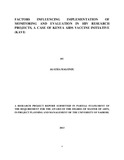| dc.description.abstract | Monitoring and evaluation system is a fundamental tool in project management aimed at checking whether the projects’ objectives and goals are being achieved. It improves the overall efficiency of project planning, management and implementation. Many of the projects funded or initiated by donors have ended up collapsing either within the project period while others that survived the project period have not proceeded further after the termination of donor support. This has raised the questions; do these projects have a well-designed monitoring and evaluations plan to ensure effective implementation of monitoring and evaluation practices? What factors affect the design and implementation of monitoring and evaluation systems in these projects ? This study was meant to establish how financial availability, staff participation, management commitment, and relevant skills influence implementation of monitoring and evaluation systems in HIV research projects which are mainly donor funded. The research design that was applied on this study was a survey design where a census of the target population was done using questionnaires as the instruments of data collection. Descriptive statistics was used as the method of data analysis. This study targeted KAVI project which is internationally funded and has been actively involved in research for the HIV Vaccine. About 43 respondents from KAVI were formally interviewed using structured questionnaires and only 38 respondents returned them. Briefing, rapport building and piloting of questionnaires and respondents was done and ensure their efficiency in terms of validity and reliability. The data collected was coded, keyed into SPSS (a computer software database version 13), organized, and cleaned for any errors that might have occurred during data collection. The data was then analyzed using descriptive statistics with aid of the SPSS and Microsoft Excel (computer software). Qualitative statistical techniques were used to describe and summarize data. The results were then interpreted in the form of descriptive statistics which are frequencies and percentages. The findings were presented in form of tables and figures. It was evident from the findings that management commitment is very influential to the implementation of monitoring and evaluation since they are key decision makers in an organization. Financial availability has control on the implementation because it is the main resource in any functional organization as far as other resources such as human are concerned. To set up a monitoring department finances are required as well as to hire staff. Staff capacity both in numbers and skills are also very instrumental in any effective implementation and sustainability of monitoring and evaluation. Without relevant skills it’s hard to master the rule of any game. Therefore, the staffs need to be equipped with the relevant skills for performance and success. This study recommended that the organization look for ways of raising funds to support the monitoring and evaluation as well as make an effort to set up a monitoring and evaluation department for efficiency and accountability. The scholars will use findings of this study as a basis for further research in implementation of monitoring and evaluation in projects to bring out more understanding in this area of study. | en |

